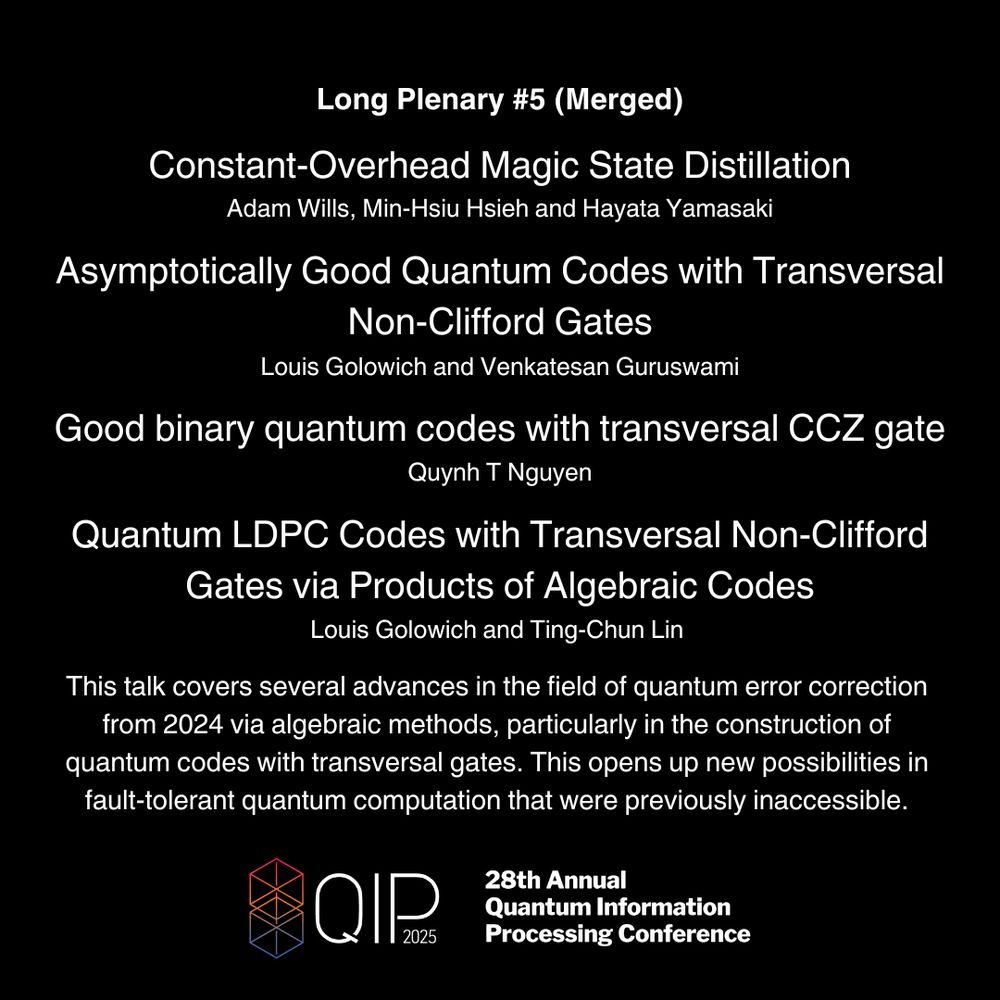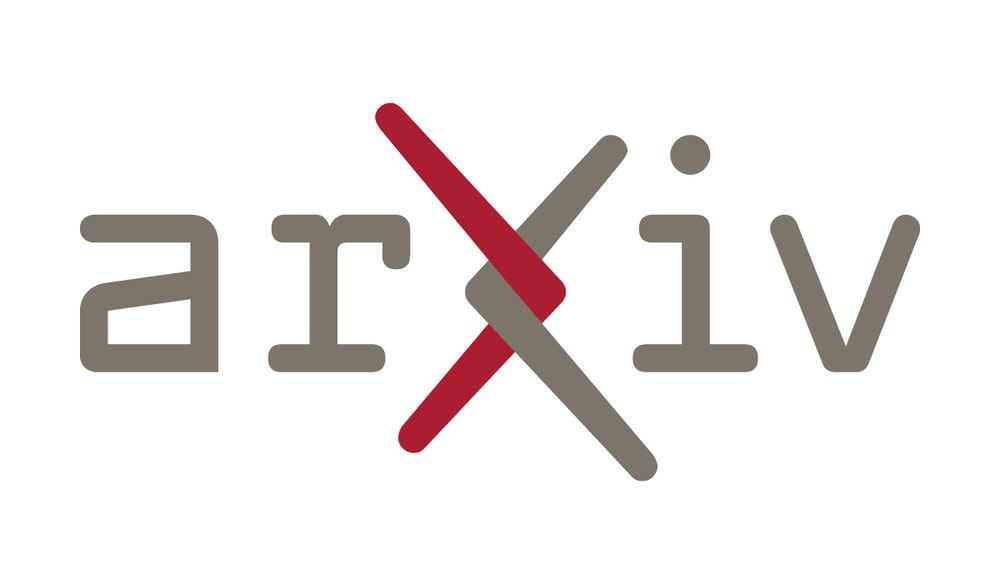We hope you enjoy and please share any comments and questions!
09.07.2025 02:33 — 👍 0 🔁 0 💬 0 📌 0
Here, the AG codes as evaluation codes are really giving you the transversality, and the transitive automorphisms are really giving you the addressability.
09.07.2025 02:33 — 👍 0 🔁 0 💬 1 📌 0
This improves upon our previous result which was only asymptotically good up to polylogarithmic factors. The secret in the end was a family of algebraic geomtry (AG) codes due to Stichtenoth with a transitive automorphism group.
09.07.2025 02:33 — 👍 0 🔁 0 💬 1 📌 0
Namely, this means that any three logical qubits, whether they’re in one, two or three blocks of the code, can be addressed with the logical CCZ gate via a depth-one circuit of physical CCZ gates.
09.07.2025 02:33 — 👍 0 🔁 0 💬 1 📌 0
Hi there. I believe you may have tagged the wrong person :)
24.04.2025 16:44 — 👍 1 🔁 0 💬 1 📌 0

Our fifth long plenary is a merged talk featuring four presentations from winners of the "Best Student Paper" award! Details and overview below. @adamwills1.bsky.social
15.02.2025 00:51 — 👍 8 🔁 1 💬 1 📌 0
Those two field elements generate an additive group of size 4.
05.02.2025 21:15 — 👍 1 🔁 0 💬 0 📌 0
Yea have a look through Section 3 in particular the end of Section 3.1. I believe that explains it better than I can here. Essentially the “differences” between the 3 logical qudits that we want to address are described by some field elements.
05.02.2025 21:15 — 👍 1 🔁 0 💬 1 📌 0
“duplicate” each qubit O(1) times to get depth one - you’ll see in the paper where we do this to get down from depth 4 to depth 1. As is common, there is a tradeoff between implementation depth and code length.
05.02.2025 19:14 — 👍 1 🔁 0 💬 1 📌 0
Yea indeed that’s exactly the angle is to say that you don’t need to incur the overhead of these other techniques if you have a nice enough code. I should also say to be fair that while we do get depth one that’s kind of equivalent to O(1) depth here because after you have depth O(1) you can just
05.02.2025 19:14 — 👍 1 🔁 0 💬 1 📌 0
Yea indeed the main idea here is a specialised code construction which allows non-Clifford addressability via constant-depth circuits (in fact depth one). I definitely want to learn more about your paper too!
05.02.2025 18:56 — 👍 1 🔁 0 💬 1 📌 0
logical and physical qubits. Therefore I don’t think it’s unreasonable at all to consider ideas in this paper as inspiration for getting addressability on algebraic LDPC constructions. I wouldn’t say the same for more topological constructions, though.
05.02.2025 16:07 — 👍 0 🔁 0 💬 0 📌 0
discovered (LDPC or otherwise). One direction of work would be then to apply these addressability ideas to LDPC constructions. While our main result does use particular properties of Reed-Solomon codes, somehow the feeling is that all we needed was a nice algebraic structure on the addresses of the
05.02.2025 16:07 — 👍 1 🔁 0 💬 2 📌 0

Constant-Overhead Magic State Distillation
Magic state distillation is a crucial yet resource-intensive process in fault-tolerant quantum computation. The protocol's overhead, defined as the number of input magic states required per output mag...
Thanks! And thanks for the question. There’s no bound on the check weights and indeed you can show that there are high weight stabilisers (linear or near-linear). The aim is, as in arxiv.org/abs/2408.07764 (and the concurrent works) to develop properties of quantum codes that have not been
05.02.2025 16:07 — 👍 1 🔁 0 💬 1 📌 0
While we hope this will be seen as a nice step forward, there is still a lot to do. For example, we really need LDPC versions of these codes. It does seem reasonable to attempt to obtain addressability on LDPC codes supporting transversal gates in a way similar to this work. Exciting times ahead!
05.02.2025 03:44 — 👍 1 🔁 0 💬 1 📌 0
We demonstrate the power of this by constructing an asymptotically good code with an addressable, transversal CCZ gate on fixed, non-overlapping triples. In another application, one can build codes with transversal, addressable T gates, up to Cliffords, although we do not provide an instantiation.
05.02.2025 03:44 — 👍 2 🔁 0 💬 1 📌 0
We also develop a general framework to describe transversal addressability which we call “addressable orthogonality”. This encompasses Bravyi and Haah’s original “triorthogonality” framework for T gates and all related notions.
05.02.2025 03:44 — 👍 1 🔁 0 💬 1 📌 0
To be explicit, given ANY triple of logical qubits in one or multiple codeblocks, you can address that triple with the logical CCZ gate via a depth-one circuit of physical CCZ operations. We discuss generalisations to other gates such as CCCZ and higher.
05.02.2025 03:44 — 👍 0 🔁 0 💬 1 📌 0
In fact, there are no such works for the hardest operations: the non-Clifford operations. We construct the first quantum codes with this property, and in fact we obtain such codes that are nearly asymptotically good (only a polylog away).
05.02.2025 03:44 — 👍 2 🔁 0 💬 1 📌 0
While this is fine for magic state distillation, we need *much* more fine-grained control for utility in general computation. There are only a small number of works studying codes supporting transversal gates that allow you to address particular logical qubits.
05.02.2025 03:44 — 👍 1 🔁 0 💬 1 📌 0
Last year, the first asymptotically good codes were constructed supporting non-Clifford transversal gates (and this led to the discovery of constant-overhead magic state distillation). However, this left open a big problem. The transversal gates executed the same logical gate on every logical qubit.
05.02.2025 03:44 — 👍 1 🔁 0 💬 1 📌 0
However, to lower the fault-tolerance overhead, we still have a long way to go to building codes with highly flexible sets of transversal gates that can adapt to a given algorithm, thus minimising the need for expensive sub-routines like magic state distillation.
05.02.2025 03:44 — 👍 0 🔁 0 💬 1 📌 0
The Eastin-Knill theorem prevents us from performing fault-tolerant quantum computation with transversal gates (i.e. executing logical gates on logical qubits via low-depth physical curcuits) alone.
05.02.2025 03:44 — 👍 1 🔁 0 💬 1 📌 0
Could you add me? Thanks!
02.12.2024 14:39 — 👍 1 🔁 0 💬 0 📌 0
A team of #QuantumErrorCorrection (QEC) experts, helping quantum computers scale and tackle errors across qubit types 🧪
www.riverlane.com
Quantum factotum @ IBM.
https://arxiv.org/a/bishop_l_1.html | https://research.ibm.com/people/lev-bishop | https://github.com/levbishop
phd student in cs theory, quantum computing at Columbia
natalieparham.com
Team lead quantum algorithms at Quantinuum. Formerly ultracold atoms and quant finance. He/him. https://mathstodon.xyz/@rosenkranz
QEC @ IBM quantum
Parent, quantum physicist, gardener
3rd year PhD Student at the University of Cambridge focusing on Quantum Computing
(he/him)
Google Scholar: https://scholar.google.com/citations?user=GRSIcsEAAAAJ
GitHub: https://github.com/Christopher-K-Long
ORCiD: https://orcid.org/0009-0001-3230-942X
Prof in Quantum Information Theory at NUS and CQT, an information theorist at the quantum frontier, ETH Zurich alumnus, opinions my own
Thinking about Quantum information at Freie Universität Berlin
antonioannamele.com
PhD student in Quantum Engineering @ University of Bristol & Quantum Scientist @ Riverlane
Research Scientist at Google Quantum AI focused on quantum error correction
Scientist, hobby naturalist
The official Bluesky account for all things quantum with IOP Publishing.
Join our community and stay connected with the latest research, news, and updates in quantum science and technology.
Explore our quantum hub here: https://shorturl.at/0kYxX
PhD candidate at Caltech in Electrical Engineering and Physics studying the fundamental physical limits of technologies.
volkangurses.com
Quantum hardware, devices, microwave
Quantum computing researcher. Research interest: quantum many body dynamics, quantum error mitigation, quantum error correction.
Grad student at MIT, looking for logical qubits. sunnyzhiyanghe.github.io


